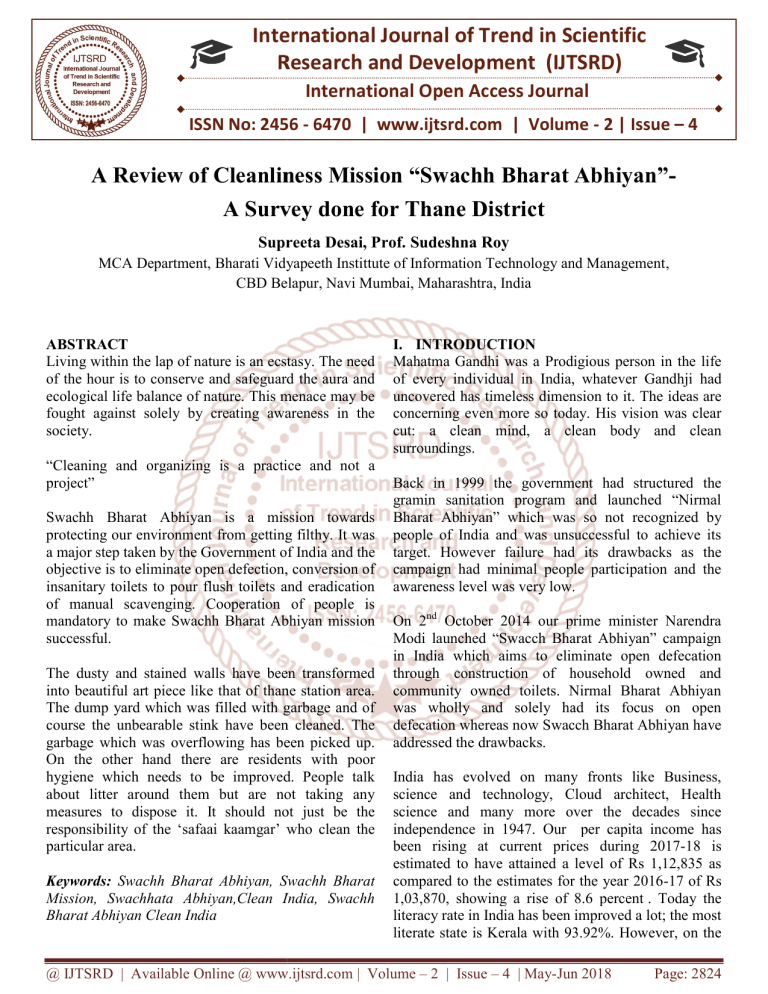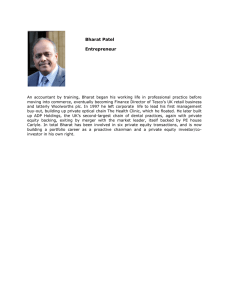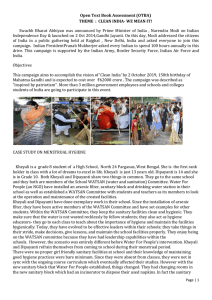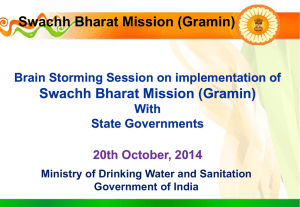
International Journal of Trend in Scientific
Research and Development (IJTSRD)
International Open Access Journal
ISSN No: 2456 - 6470 | www.ijtsrd.com | Volume - 2 | Issue – 4
A Review of Cleanliness Mission “Swachh Bharat Abhiyan”Abhiyan”
A Survey
urvey done for Thane District
Supreeta Desai, Prof. Sudeshna Roy
MCA Department, Bharati Vidyapeeth Instittute of Information Technology and Management,
Management
CBD Belapur, Navi Mumbai, Maharashtra, India
ABSTRACT
Living within the lap of nature is an ecstasy. The need
of the hour is to conserve and safeguard the aura and
ecological life balance of nature. This menace may be
foughtt against solely by creating awareness in the
society.
“Cleaning and organizing is a practice and not a
project”
Swachh Bharat Abhiyan is a mission towards
protecting our environment from getting filthy. It was
a major step taken by the Government of Ind
India and the
objective is to eliminate open defection, conversion of
insanitary toilets to pour flush toilets and eradication
of manual scavenging. Cooperation of people is
mandatory to make Swachh Bharat Abhiyan mission
successful.
The dusty and stained walls have been transformed
into beautiful art piece like that of thane station area.
The dump yard which was filled with garbage and of
course the unbearable stink have been cleaned. The
garbage which was overflowing has been picked up.
On the other hand there are residents with poor
hygiene which needs to be improved. People talk
about litter around them but are not taking any
measures to dispose it. It should not just be the
responsibility of the ‘safaai kaamgar’ who clean the
particular area.
Keywords: Swachh Bharat Abhiyan, Swachh Bharat
Mission, Swachhata Abhiyan,Clean India, Swachh
Bharat Abhiyan Clean India
I. INTRODUCTION
Mahatma Gandhi was a Prodigious person in the life
of every individual in India,
ndia, whatever Gandhji had
uncovered has timeless dimension
dimen
to it. The ideas are
concerning even more so today. His vision was clear
cut: a clean mind, a clean body and clean
surroundings.
Back in 1999 the government had structured the
gramin sanitation program and launched “Nirmal
Bharat Abhiyan” which was so not recognized by
people of India and was unsuccessful to achieve its
target. However failure had its drawbacks as the
campaign had minimal people participation and the
awareness level was very low.
On 2nd October 2014 our prime minister Narendra
Modi launched “Swacch Bharat Abhiyan” campaign
in India which aims to eliminate open defecation
through construction of household owned and
community owned toilets. Nirmal Bharat Abhiyan
was wholly and solely had its focus on open
defecation whereas now Swacch Bharat Abhiyan have
addressed the drawbacks.
India has evolved on many fronts like Business,
science and technology, Cloud architect, Health
science and many more over the decades since
independence in 1947. Our per capita income has
been rising at current
nt prices during 2017-18
2017
is
estimated to have attained a level of Rs 1,12,835 as
compared to the estimates for the year 2016-17
2016
of Rs
1,03,870, showing a rise of 8.6 percent . Today the
literacy rate in India has been improved a lot; the most
literate statee is Kerala with 93.92%. However, on the
@ IJTSRD | Available Online @ www.ijtsrd.com | Volume – 2 | Issue – 4 | May-Jun
Jun 2018
Page: 2824
International Journal of Trend in Scientific Research and Development (IJTSRD) ISSN: 2456-6470
Contrary, India has the largest numbers of
malnourished people in the world. Studies show that
malnourishment is not only lack of proper nutrition
but also access to hygiene, safe drinking water and
food. Many water related diseases like cholera,
diarrhea, malaria, typhoid and filariasis erupt every
year in India due to poor quality drinking water and
sanitation. Access to safe water and sanitation are
crucial for a healthier lifestyle.
India’s 1.32 billion people live in large number of
rural as well as urban habitations. The cities such as
Mumbai, Bangalore, Delhi, Ahmadabad and
Hyderabad are considers as the most populated cities
in India. The population density is around 412 people
per square kilometer, which ranks 31st in the world.
Around 70% of India’s population live in rural area so
about one-third population i.e. 30% population live in
urban area. So looking at the statistics we need to
determine the sanitation program differently in both
the rural as well as urban area.
II. LITRATURE SURVEY:
1. List of facilities provided by swachhata
abhiyan.
As of today Swachh Bharat Abhiyan has cover more
than 7 .5 crore households, 3.8 lakh open defecation
free villages, more than 4,465 open defecation free
villages in namami gange, 395 open defecation free
districts and 17 open defecation free states/UTs as of
June 2018.
A. Swachh bharat mission (Urban area)
The mission had its precedence i.e. to bring
behavioral changes in people regarding healthy and
hygienic lifestyle, eliminating solid waste and
scavenging, conversion of unsanitary toilets to pour
flush toilets and completely eradicating open
defecation. Public toilets have been build in various
location around like the bus stops, railway stations,
tourist places, markets and also in slum areas the
government is progressively planning to build more
toilets. Rs 4000/- is given to every household for
construction of a toilet by the government of India
where 2000/- will is given as first installment after
verification and 2000/- will be given after under
construction toilet photographs are sent as a proof to
ministry, additionally, 1300 per household will be
given as an incentive. Swachh Bharat for Urban area
has constructed around 34 lakh toilets.
According to the guidelines of Swachh Bharat
Mission (Urban) tentative basic cost for community
toilets is Rs. 65,000/- per seat which has been revised
with additionally Rs. 39,200/- per seat and for public
toilets is Rs. 75,000/- per seat which has been revised
with additionally Rs. 12,800/- per seat.
B. Swachh bharat mission (Gramin or Rural area)
Nirmal bharat abhiyan which was initially called as
total sanitation campaign was planned to make india
an open defecation free in gramin area through proper
management of solid and liquid waste.Swachh bharat
gramin has build over 5.3 crore toilets. In rural India,
3.8 lakh villages, have been declared open defecationfree.
Swachh bharat gramin has been allocated Rs.13,948
crore in 2017-2018. Total Rs.10,000-Rs.12,000 per
unit fund allocation has been given for rural toilets
and Rs.35,000 has be given for school toilets. For
anganwadi toilets,the funds provided is Rs. 8,000 and
community toilets is Rs.2 lakh. The mission is been
carried out with involvement of every gram panchayat
i.e. village council, panchayat samiti and Zila
parishad. Also school Children and teachers have put
efforts in making this mission successful. The main
Mission is to contribute in construction of individual
household latrine in rural development.
2. Promotion or advertisement.
Bollywood celebrities play powerful impact on today’s
youth. The government of India hence collaborated with
several celebrities for this purpose with an intent to carry
out an Open-Defecation Free (ODF) India by 2 October
2019. Various personalities who have promoted the cause
include Amitabh Bachchan, Anushka Sharma, Shilpa
Shetty, Virat Kohli, Priyanka Chopra, Sachin Tendulkar
and Salman Khan. While some of these personalities like
vidya balan, Amitabh Bachchan featured in the ad
campaigns; others were seen encouraging the motive by
picking a broom. Around Rs 530 crore was spent for the
marketing the Swachh Bharat Abhiyaan in three years.
3. NGO’s which promotes swachhata abhiyan.
The NGO’s are the non-governmental organizations
who work independently of any government whose
whole idea is to handle issues that are either social or
political. Various NGO’s like SWaCH pune(Solid
Waste Collection and Handling), The Ugly Indian and
Waste warriors.
@ IJTSRD | Available Online @ www.ijtsrd.com | Volume – 2 | Issue – 4 | May-Jun 2018
Page: 2825
International Journal of Trend in Scientific Research and Development (IJTSRD) ISSN: 2456-6470
III. OBJECTIVE:
1. To understand and identify the programs or
facilities by government through swacchata
abhiyan.
2. To know the awareness of facilities.
3. To identify the use of facilities.
IV. HYPOTHESIS:
H0: There is no correlation between awareness and
utilization of facilities.
H1: There is positive correlation between awareness
and utilization of facilities.
V. Research Questionnaire:
Thane made a forward leap from 116 to 40 according to a recent article by times of India.
Sr No.
Questions
Options
1.
Are you aware of the Nirmal Bharat Abhiyan?
1. yes
2. no
2.
Are you aware of the Swachh Bharat Abhiyan?
1. yes
2. no
3.
Are you interested in contributing to the Swachh Bharat 1.
Strongly Disagree
Abhiyan
2.
Disagree
3.
Neutral
4.
Agree
5.
Strongly Agree
4.
Is 24 hour water available in /for the toilet?
1.yes
2.no
3.sometimes
5.
Do you prefer using Public Toilet?
1.yes
2.no
6.
Is there any Open Defecation spot /excreta in an open 1.yes
place?
2.no
7.
Do you still find plastic being used at around you in 1.yes
market instead of a eco friendly bag
2.no
8.
Are you using plastic bags instead of eco friendly bags ?
1.yes
2.no
9.
Do you know about the Swachh Bharat Abhiyan app?
1. yes
2. no
3. no idea
10.
Have you used the Swachh Bharat Abhiyan app?
1. yes
2. no
3. no idea
11.
Do you think that hoarding and advertisment are enough 1. yes
to spread the awarness about Swachh Bharat Abhiyan?
2. no
12.
13.
14.
15.
16.
Do you know about wet or dry garbage
1. yes
2. no
3. no idea
At home do you maintain separate Wet and Dry Garbage? 1. yes
2. no
3. no idea
Do you find less littering on road?
1. yes
2. no
3. no idea
In your perception would the swatch Bharat Abhiyan 1. yes
change the mindset of the people?
2. no
3. no idea
Rate the cleanliness of the public toilets in your area
1 to 5
@ IJTSRD | Available Online @ www.ijtsrd.com | Volume – 2 | Issue – 4 | May-Jun 2018
Page: 2826
International Journal of Trend in Scientific Research and Development (IJTSRD) ISSN: 2456-6470
VI. RESEARCH METHODOLOGY:
Primary Data:
Survey forms are distributed to the local residents of
thane for data collection. Survey forms contain
Questionnaire. The reasons were:
1. To determine whether or not the queries chosen are
going to be relevant in addressing the set objectives
of the analysis and conjointly to update form and
discard pointless queries.
2. To rectify errors before the specific questionnaires
go out to the particular respondents.
3. To calculate the intermediate response rate within
the use of numerous medium for information
collection.
VII.
Data Analysis and Interpretation
Interpretation: The above Result shows that 52.9%
people are aware about nirmal bharat abhiyan and the
rest were unaware about it.
We have prepared semi-open ended questions. These
questions allocated have no restrictions on how
research participants could respond to the questions.
Participants reply to the given questionnaire according
to their own opinion with closed ended questions.
Secondary Data:
Secondary research methodology defined as Data
which were gathered from miscellaneous sources,
inclusive of reference materials like dictionaries,
archival sources, textbooks, journals/articles,
review and online sites.
Interpretation: The above Result shows 96.1% people
are aware about swachh bharat abhiyan.
In secondary research methodology, we have refer
various application on the playstore listed below:
1. Swachhata-MoHUA
2. Swachh Bharat Abhiyaan
3. Swachh Bharat Clean India App
4. My Clean India
Also, Radio stations and TV channels promote
‘swachhta hi seva’ campaign.
Sample Size
The population under-study which consists of local
residents in thane district of 18.9 lakhs as of july
2018, it is remarkably impossible to interview such
chaotic amount of population. So a part of population
is referred as sample for the survey. 51 members from
Lodha Paradise in Thane district were surveyed which
included 23 female and 28 male.
Interpretation: According to our survey 25.5%
strongly Agree, 47.1% Agree, 19.6% Neutal, 7.8%
disagree to show contribution to Swachh Bharat
Abhiyan.
@ IJTSRD | Available Online @ www.ijtsrd.com | Volume – 2 | Issue – 4 | May-Jun 2018
Page: 2827
International Journal of Trend in Scientific Research and Development (IJTSRD) ISSN: 2456-6470
Interpretation: The water facility is 24 hours in the
residence according to 64.7% of the people who have
been surveyed.
Interpretation: 37.3% prefer using public toilets
whereas 33.3% disagree with it and some are on the
neutral side.
Interpretation: 41.2% have given a positive outlook
whereas 31.4% disagree.
Interpretation: Recently the government has banned
plastics but still 86.3% have noticed of plastic still
been used.
Interpretation:49% people use plastic bags where as
51% show a positive response and are using eco
friendly bags instead of plastic.
Interpretation: swachh bharat app can also be used to
directly connect with the ‘safai karamcharwala’ to
keep their surroundings clean yet 37.7% and 23.5%
are not using and have no knowledge of it.
Interpretation: 76.5% do not use the SBA app but
13.7% have used the SBA.
Interpretation: 84.3% still think that hoarding and
advertisement are just not enough to create awareness
among the people.
@ IJTSRD | Available Online @ www.ijtsrd.com | Volume – 2 | Issue – 4 | May-Jun 2018
Page: 2828
International Journal of Trend in Scientific Research and Development (IJTSRD) ISSN: 2456-6470
Interpretation: 90.2% have knowledge about wet or
dry garbage. Managing separate dry or wet waste is
mandatory for recycling purpose.
Interpretation: Even after 90% people having
knowledge about wet and dry waste people still do not
maintain separate dustbins.47.1% still do not use
separate dustbins whereas 51% use separate dustbins.
Interpretation: 41.2% find less littering on road
whereas 58.8% find more littering in their
surroundings.
Interpretation: The above histogram shows the
cleanliness of public toilets which has 19 people have
rated it 3 which is average and 15 people have rated
as below average. Only 3 people have rated as
excellent.
VIII. Result and discussion
This chapter analyses the responses given by the
locals of thane district through the administration of
structured questionnaire conducted. In order to make
interpretation and analysis easier, tables are presented
using Chi-Square test for the above analyzed data.
Table I
Usage of SBA
Count
Percentage
Strongly
Disagree
1
1%
Agree
24
24%
Disagree
3
3%
Neutral
10
10%
Strongly Agree
13
13%
Total
51
100%
Table I represents usage of SBA interview on various
areas from thane district.
Table II
Awareness of SBA Count
Interpretation: only 35.3% agree that SBA has change
the mindset of the people. Whereas 52.9% are hoping
that SBA might change the mindset of the people.
11.8% still disagree.
Percentage
Yes
48
48%
No
2
2%
Total
51
100%
Table II represents the awareness of SBA. Out of
these, 48% represent people who are aware of SBA.
@ IJTSRD | Available Online @ www.ijtsrd.com | Volume – 2 | Issue – 4 | May-Jun 2018
Page: 2829
International Journal of Trend in Scientific Research and Development (IJTSRD) ISSN: 2456-6470
Table III
Rate of Cleanliness Count
Percentage
3. https://en.wikipedia.org/wiki/Swachh_Bharat_Ab
hiyan
1
6
6%
4. http://www.swachhbharaturban.in/sbm/home/
2
15
15%
5. https://www.indexmundi.com/india/demographics
_profile.html
3
19
19%
4
8
8%
5
3
3%
6. https://www.researchgate.net/publication/2792018
08_Swachh_Bharat_Mission_A_Step_towards_En
vironmental_Protection
Total
51
100%
Table III represents the rate of cleanliness with
respect to their public area who are interested to
Contribute for SBA.
IX. Conclusion:
1. It is necessary to educate young children to make
cleanliness as habit and not a responsibility.
2. People should use the SBA app to complain or
inform about any garbage or litter in surrounding
areas.
3. Heavy fine should be demanded from the people
who litter or spit in public areas.
If these points are followed by people then there
might be ‘Acche Din’ very soon.
X. Reference:
1. https://www.researchgate.net/profile/Aparna_Nay
ak/publication/280939151_Clean_India/links/560
433ab08aeb5718feee475.pdf
2. http://questforequity.org/contents/Papers/No%20S
wachh%20Bharat%20without%20Annihilation%2
0of%20Caste.pdf
7. http://www.indiacelebrating.com/essay/swachhbharat-abhiyan-essay/
8. https://www.readycleaningserviceskc.com/singlepost/2016/05/28/Cleaning-and-Organizing-is-aPractice-Not-a-Project
9. https://timesofindia.indiatimes.com/city/thane/min
dset-change-is-the-key-to-cleancampaign/articleshow/61520562.cms
10. https://timesofindia.indiatimes.com/city/mumbai/s
wachh-ranking-navi-mumbai-in-top-10-big-leapsfor-mum-and-thane/articleshow/64716990.cms
11. https://www.livemint.com/Politics/wLpq03qE6gk
VL9FlCQMzgL/Govt-asks-radio-stations-TVchannels-to-boost-Swachhta-Hi-S.html
12. https://www.slideshare.net/AnirudhMehta24/empi
rical-study-on-measuring-attitude-and-perceptionof-people-towards-swachh-bharat-abhiyan
13. https://www.slideshare.net/aditieedeshpande/busin
ess-research-methods-project
14. https://www.hindustantimes.com/mumbainews/thane-clean-up-drive-to-end-on-a-highnote/story-hEcwcMQQ0oMkQ8UwysUdRL.html
@ IJTSRD | Available Online @ www.ijtsrd.com | Volume – 2 | Issue – 4 | May-Jun 2018
Page: 2830






